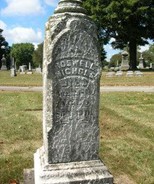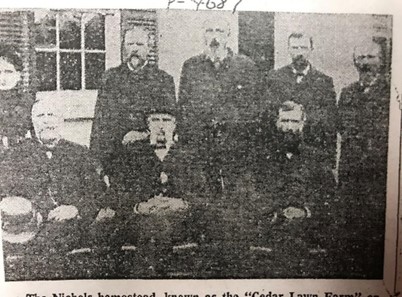
Roswell Nichols, son of Joseph Argailous Nichols and Comfort Burton, was born on July 13, 1795 in Stepney, Fairfield County, Connecticut. Roswell received a fair education and served a regular apprenticeship in the tanner and currier trades.[1]
In 1809, Roswell was on a jury list in Manchester, Ontario County.[2] Five years later, he moved to Pultneyville, Wayne County, New York, where he married Maria Gibson. She died with her young child about a year after their marriage.[3]
In 1822, Roswell married Mary Durfee, daughter of Lemuel Durfee Sr. They resided in Pultneyville where three of their children were born.[4] In 1828, they moved to Palmyra.[5] In 1829, Roswell and his family moved into the Joseph Smith Sr. frame house after the Smiths were evicted by Lemuel Durfee Jr.
In 1833, Roswell owned part of Lot 1 in Manchester which consisted of 100 acres valued at $1,350. He was expected to pay a property tax of $3.43. His affidavit against the Smiths was printed in Mormonism Unvailed:
Manchester, Ontario County Dec. 1st, 1833.
I, Roswell Nichols, first became acquainted with the family of Joseph Smith, Sen. nearly five years ago, and I lived a neighbor to the said family about two years. My acquaintance with the family has enabled me to know something of its character for good citizenship, probity and veracity —For breach of contracts, for the non-payment of debts and borrowed money, and for duplicity with their neighbors, the family was notorious. Once, since the Gold Bible speculation commenced, the old man was sued; and while the sheriff was at his house, he lied to him and was detected in the falsehood. Before he left the house, he confessed that it was sometimes necessary for him to tell an honest lie, in order to live. At another time, he told me that he had received an express command for me to repent and believe as he did, or I must be damned, I refused to comply, and at the same time told him of the various impositions of his family. He then stated their digging was not for money but it was for the obtaining of a Gold Bible. Thus contradicting what he had told me before: for he had often said, that the hills in our neighborhood were nearly all erected by human hands—that they were all full of gold and silver. And one time, when we were talking on the subject, he pointed to a small hill on my farm, and said, “In that hill there is a stone which is full of gold and silver. 1 know it to be so, for I have been to the hole, and God said unto me, go not in now, but at a future day you shall go in and the hook open, and then you shall have the treasures.” He said that gold and silver was once as plenty as the stones in the field are now—that the ancients, half of them melted the ore and made the gold and silver, while the other half buried it deeper in the earth, which accounted for these hills. Upon my enquiring who furnished the food for the whole, he flew into a passion, and called me a sinner, and said he, “You must be eternally damned.” I mention these facts, not because of their intrinsic importance, but simply to show the weak mindedness and low character of the man.
ROSWELL NICHOLS[6]
On April 9, 1834, executors of Lemuel Durfee’s estate deeded the Joseph Smith Sr. property to Mary Nichols. Three years later on November 6, 1837, Mary Durfee wrote, “Willard Thayer hired out 30 dollars to Roswell Nichols the note was dated 7th when it should have been 6th.”[7] She also wrote on June 20, 1840, “John & Prudence Hussey came here. Prudence D., Oliver D., Lucy, Roswell Nickles & Mary were here. I had a singular sensation had to leave our company & lied down.”[8]
In autumn of 1841, being impressed with tales of better soil in Illinois, Roswell traded the farm in New York for a tract of 640 acres situated on the bank of the Kankakee River in what is now Limestone, Kankakee County. Though much of the tract was prairie, there was enough timber and meadowland to make it a success. Roswell eventually purchased 10,040 acres valued at $8 an acre.[9] (In 1904, the same land was valued at $125 an acre.)[10]
In the spring of 1842, Roswell and his family traveled via the Erie Canal to Buffalo and then to Chicago by steamer. In Chicago, Roswell hired seven teams and wagons to bring himself, his family (which consisted of nine children ranging in age from eighteen years old to six months) and goods to his new home. He spent the first night at the present site of Lockport. The second day, he purchased a flour mill in Wellington.[11] Soon after, Roswell and his family moved to a log cabin home on the banks of the Kankakee River. With the help of his sons, Roswell improved the farm, erected buildings, opened roads, and soon had one of the most valuable farms in the state. His nearest neighbor lived five miles away. He later helped organize the Republican Party in Kankakee. When the Republican Party decided to form a justice court in Limestone Township, Roswell filled the position for many years. He served as postmaster in Kankakee for over twenty-five years. He was succeeded as a postmaster by his son, Franklin Nichols.[12]
Roswell was listed in the 1850 US Federal Census as age fifty-four, residing in District 21 in Iroquois, Illinois.[13] He homesteaded on the south bank of the Kankakee River in Limestone Township.
On June 2, 1855, eight of Roswell and Mary’s surviving children posed for a photograph in front of the family homestead built in 1845.

In 1860, Roswell was listed in the US Federal Census as age sixty-five, residing in Limestone, Kankakee County. His occupation was a farmer. His real wealth was $1,200 and his personal wealth was $1,441. In his household were Roswell McHole, Mary McHole, Bailey H. McHole, Charles McHole, Franklin McHole, and Albert McHole.
Roswell was a private and a fifer in the 92nd Regiment of the Illinois Infantry. He fought with the infantry in the Civil War. Following the war, he and his wife moved to Kankakee, where they spent their remaining years.[14] On August 3, 1880, Roswell died in Kankakee City at age 85 years and 19 days.[15] He adhered to the Presbyterian faith. His wife never abandoned the faith of her parents, but there was no Society of Friends near her home to attend.[16]
[1] Portrait and Biographical Records, Kankakee Co., Illinois (1893), p, 335.
[2] 19th Century Jury List Ontario County to 1855.
[3] Portrait and Biographical Records, Kankakee Co., Illinois (1893), p, 335.
[4] Portrait and Biographical Records, Kankakee Co., Illinois (1893), p, 335.
[5] Portrait and Biographical Records, Kankakee Co., Illinois (1893), p, 335.
[6] Howe, Mormonism Unvailed, pp. 257–258, 347, 360–361.
[7] Mary Durfee Diary, 1837–1838.
[8] Mary Durfee Diary, 1837–1838.
[9] Portrait and Biographical Records Kankakee Co., Illinois (1893), p. 335.
[10] “Life of the Early Settlers of Kankakee River Valley,” Kankakee Gazette, October 25, 1904.
[11] “All about a Former Palmyra Man,” Palmyra Register, January 26, 1920.
[12] Portrait and Biographical Records, Kankakee Co., Illinois (1893), p. 335.
[13] “All about a Former Palmyra Man,” Palmyra Register, January 26, 1920.
[14] Portrait and Biographical Records, Kankakee Co., Illinois (1893), p. 335.
[15] “All about a Former Palmyra Man,” Palmyra Register, January 26, 1920.
[16] Portrait and Biographical Records, Kankakee Co., Illinois (1893), p. 335.
